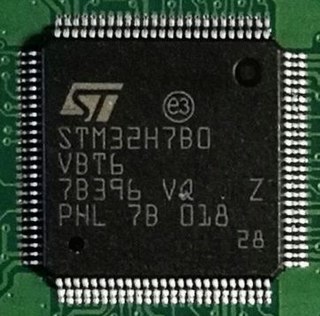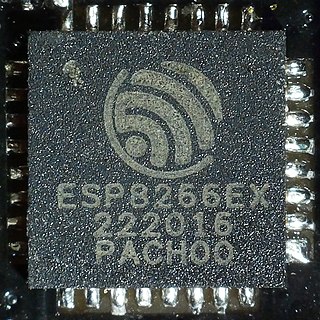Pmod interface (peripheral module interface) is an open standard defined by Digilent in the Pmod Interface Specification [1] for connecting peripheral modules to FPGA and microcontroller development boards using 6 pins. Pmod or Pmods may also refer to modules compatible with the Pmod interface.
Pmods are available from simple push buttons to more complex modules with network interfaces, analog to digital converters or liquid-crystal displays. These modules can be used with a variety of FPGA or microcontroller development boards from different vendors. The Pmod interface is designed so Pmods can be quickly connected to host boards for prototyping or evaluation purposes without soldering, but Pmods aren't quite plug and play since software and configuration is required.
Pmods come with a standard 6-pin interface of 4 signals, one ground and one power pin. Double and quad Pmods also exist. These duplicate the standard interface to allow more signals to pass through to the module.
Pmods can use either SPI, I2C or UART protocol. With I2C it is possible to use a 4-pin connector. Alternatively the pins 1 to 4 can be used as simple digital I/O pins.
Digilent was founded in 2000 by two Washington State University electrical engineering professors. [2]
In 2011, v1.0.0 of Pmod Interface Specification was released. [3]
In January 2013, National Instruments acquired all outstanding shares of Digilent Inc., which became a wholly owned subsidiary. [4]
| Year | Version | Notes | Refs |
|---|---|---|---|
| 2011 | 1.0.0 | First release | [3] |
| 2017 | 1.1.0 | . | [5] |
| 2017 | 1.2.0 | . | [6] |
| 2020 | 1.3.0 | . | [7] |
| 2020 | 1.3.1 | Current release | [1] |

AVR is a family of microcontrollers developed since 1996 by Atmel, acquired by Microchip Technology in 2016. These are modified Harvard architecture 8-bit RISC single-chip microcontrollers. AVR was one of the first microcontroller families to use on-chip flash memory for program storage, as opposed to one-time programmable ROM, EPROM, or EEPROM used by other microcontrollers at the time.

I2C (Inter-Integrated Circuit; pronounced as “eye-squared-see” or “eye-two-see”), alternatively known as I2C or IIC, is a synchronous, multi-controller/multi-target (historically-termed as master/slave), single-ended, serial communication bus invented in 1982 by Philips Semiconductors. It is widely used for attaching lower-speed peripheral ICs to processors and microcontrollers in short-distance, intra-board communication.

The MSP430 is a mixed-signal microcontroller family from Texas Instruments, first introduced on 14 February 1992. Built around a 16-bit CPU, the MSP430 was designed for low power consumption embedded applications and low cost.
Serial Peripheral Interface (SPI) is a de facto standard for synchronous serial communication, used primarily in embedded systems for short-distance wired communication between integrated circuits.

1-Wire is a wired half-duplex serial bus designed by Dallas Semiconductor that provides low-speed (16.3 kbit/s) data communication and supply voltage over a single conductor.
JTAG is an industry standard for verifying designs of and testing printed circuit boards after manufacture.
A general-purpose input/output (GPIO) is an uncommitted digital signal pin on an integrated circuit or electronic circuit board which may be used as an input or output, or both, and is controllable by software.
MIDIbox is a non-commercial open source project with a series of guides on how to build musical instrument device interfaces (MIDI). Through a series of do it yourself tutorials, users are guided in the process of building a basic microcontroller that can also be used to build hardware MIDI control units for various synthesizers, multi-track recording software, and other MIDI devices; as well as stand-alone synthesizers, sequencers and other projects.
Universal EXTension (UEXT) is a connector layout which includes power and three serial buses: Asynchronous, I2C, and SPI separately over 10 pins in a 2x5 layout. The connector layout was specified by Olimex Ltd and declared an open-project that is royalty-free in 2011, and was used in all their boards after 2004.
ITUpSAT1, short for Istanbul Technical University picoSatellite-1, is a single CubeSat built by the Faculty of Aeronautics and Astronautics at the Istanbul Technical University. It was launched on 23 September 2009 atop a PSLV-C14 satellite launch vehicle from Satish Dhawan Space Centre, Sriharikota, Andhra Pradesh in India, and became the first Turkish university satellite to orbit the Earth. It was expected to have a minimum of six-month life term, but it is still functioning for over two years. It is a picosatellite with side lengths of 10 centimetres (3.9 in) and a mass of 0.990 kilograms (2.18 lb).

FPGA Mezzanine Card (FMC) is an ANSI/VITA 57.1 standard that defines I/O mezzanine modules with connection to an FPGA or other device with re-configurable I/O capability. It specifies a low profile connector and compact board size for compatibility with several industry standard slot card, blade, low profile motherboard, and mezzanine form factors.

STM32 is a family of 32-bit microcontroller integrated circuits by STMicroelectronics. The STM32 chips are grouped into related series that are based around the same 32-bit ARM processor core: Cortex-M0, Cortex-M0+, Cortex-M3, Cortex-M4, Cortex-M7, Cortex-M33. Internally, each microcontroller consists of ARM processor core(s), flash memory, static RAM, debugging interface, and various peripherals.

LPC is a family of 32-bit microcontroller integrated circuits by NXP Semiconductors. The LPC chips are grouped into related series that are based around the same 32-bit ARM processor core, such as the Cortex-M4F, Cortex-M3, Cortex-M0+, or Cortex-M0. Internally, each microcontroller consists of the processor core, static RAM memory, flash memory, debugging interface, and various peripherals. The earliest LPC series were based on the Intel 8-bit 80C51 core. As of February 2011, NXP had shipped over one billion ARM processor-based chips.

ATtiny is a subfamily of the popular 8-bit AVR microcontrollers, which typically has fewer features, fewer I/O pins, and less memory than other AVR series chips. The first members of this family were released in 1999 by Atmel.
Netduino was an open-source electronics prototyping platform based on the .NET Micro Framework. It uses the ARM Cortex-M 32-bit RISC ARM processor core as a 32-bit ARM-microcontroller. The Netduino boards are designed to be pin-compatible with most Arduino shields. Applications can be built on Windows, or on Mac OS. The platform is similar in concept to the Arduino platform, but is generally more powerful and instead of writing applications in C/C++ or Wiring, applications are written in C#, which brings powerful, high-level language constructs to the toolbox such as threading, event handling, automatic garbage collection, and more.

Smart Mobility Architecture (SMARC) is a computer hardware standard for computer-on-modules (COMs). SMARC modules are specifically designed for the development of extremely compact low-power systems, such as mobile devices.

The Arduino Uno is an open-source microcontroller board based on the Microchip ATmega328P microcontroller (MCU) and developed by Arduino.cc and initially released in 2010. The microcontroller board is equipped with sets of digital and analog input/output (I/O) pins that may be interfaced to various expansion boards (shields) and other circuits. The board has 14 digital I/O pins, 6 analog I/O pins, and is programmable with the Arduino IDE, via a type B USB cable. It can be powered by a USB cable or a barrel connector that accepts voltages between 7 and 20 volts, such as a rectangular 9-volt battery. It has the same microcontroller as the Arduino Nano board, and the same headers as the Leonardo board. The hardware reference design is distributed under a Creative Commons Attribution Share-Alike 2.5 license and is available on the Arduino website. Layout and production files for some versions of the hardware are also available.
The MSP432 is a mixed-signal microcontroller family from Texas Instruments. It is based on a 32-bit ARM Cortex-M4F CPU, and extends their 16-bit MSP430 line, with a larger address space for code and data, and faster integer and floating point calculation than the MSP430. Like the MSP430, it has a number of built-in peripheral devices, and is designed for low power requirements. In 2021, TI confirmed that the MSP432 has been discontinued and "there will be no new MSP432 products".

The ESP8266 is a low-cost Wi-Fi microcontroller, with built-in TCP/IP networking software, and microcontroller capability, produced by Espressif Systems in Shanghai, China.

The Arduino Nano is an open-source breadboard-friendly microcontroller board based on the Microchip ATmega328P microcontroller (MCU) and developed by Arduino.cc and initially released in 2008. It offers the same connectivity and specs of the Arduino Uno board in a smaller form factor.